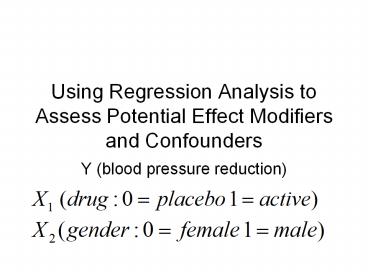Using Regression Analysis to Assess Potential Effect Modifiers and Confounders - PowerPoint PPT Presentation
Title:
Using Regression Analysis to Assess Potential Effect Modifiers and Confounders
Description:
Title: Using Regression Analysis to Assess Potential Effect Modifiers and Confounders Author: Gordon Hilton Fick Last modified by: Gordon Hilton Fick – PowerPoint PPT presentation
Number of Views:163
Avg rating:3.0/5.0
Title: Using Regression Analysis to Assess Potential Effect Modifiers and Confounders
1
Using Regression Analysis to Assess Potential
Effect Modifiers and Confounders
- Y (blood pressure reduction)
2
Question
- Does the effect of the drug on Mean BPR depend on
the gender of the patient? - It turns out that we can build a model to address
this question.
3
Implications of this model
- By specializing the model to the females and then
to the males we can see - Measures the difference between the 2 drug
effects - i.e. whether gender is an effect modifier
4
Sometimes a table can aid in understanding the
implications of a model
5
Assess effect modification first
- If gender is a modifier, its assessment as a
confounder is rarely relevant. - If there is evidence that then one
should present the gender specific estimates of
the drug effect (together with their SEs and
maybe CIs too) - No further testing of the components of this
model is typically required. - Since we know that we then know that
the drug has an effect and that the effect
DEPENDS on the gender of the patient.
6
What if gender is not an effect modifier?
- And we can then assess whether gender is a
confounder by comparing - With
7
In other words
- By studying the context, using confidence
intervals and other epidemiological ideas
8
What if the potential modifier/confounder is
continuous? Say age
- Now look at
- As 2 straight lines in age
- And so the drug effect is the difference
9
(No Transcript)
10
Age specific drug effect
- From the previous graph
- Compare the vertical difference between the red
line and the blue line when ld 3 with the
vertical difference when ld 7. - For example, red minus blue (drug effect) is
about -3 (when ld3) and a bit more than 2 (when
ld7) - The next graph shows the drug effect (de)
versus ld demonstrating that ld is a modifier.
11
(No Transcript)
12
The next graph shows
- A Drug effect adjusted for ld
- Notice that the 2 lines are parallel and that the
drug effect (red line minus blue line) is the
same for any value of ld - This fixed difference is the adjusted drug
effect
13
(No Transcript)
14
Crude drug effect
- In the next graph, the 2 lines are horizontal (to
emphasize that the effect is NOT adjusted for ld)
- In this illustration, the adjusted effect and
crude effect are nearly the same and hence there
is no evidence of confounding - Remember, though, that if we had demonstrated
modification, we would not even address the issue
of confounding
15
(No Transcript)































